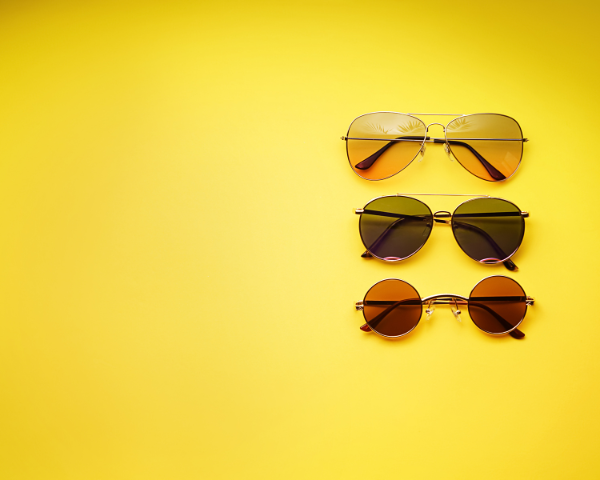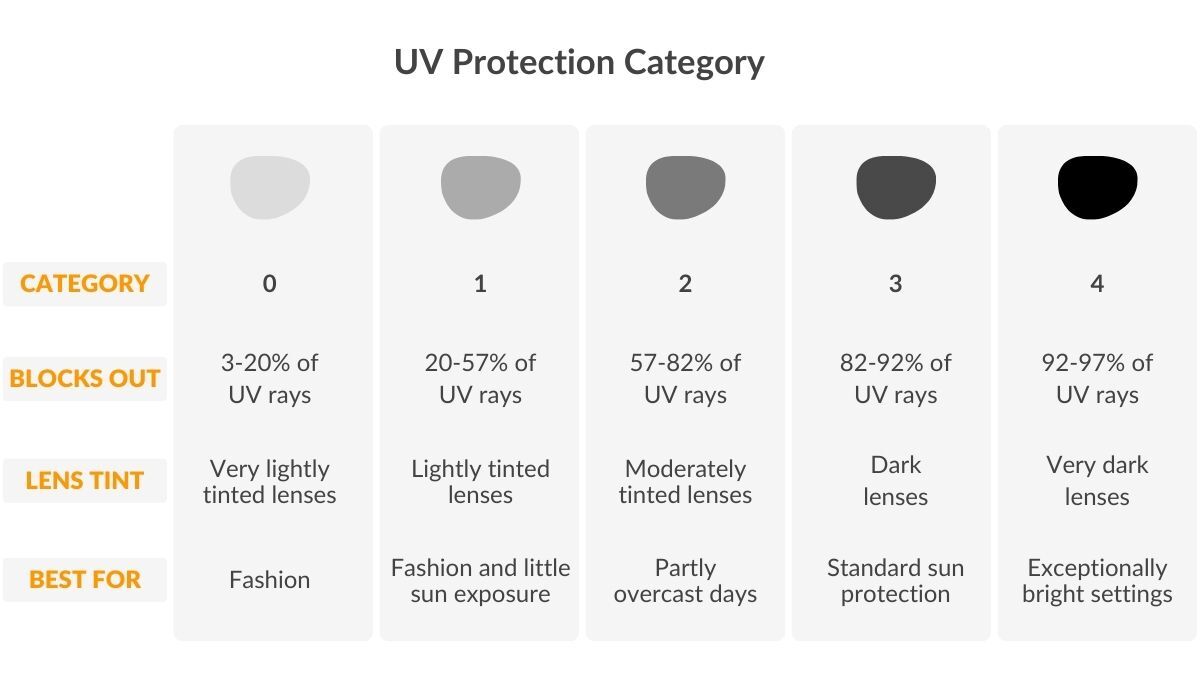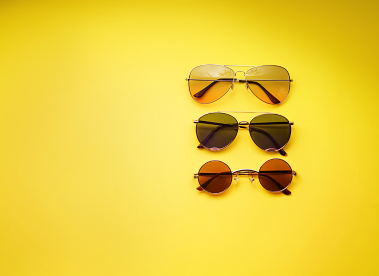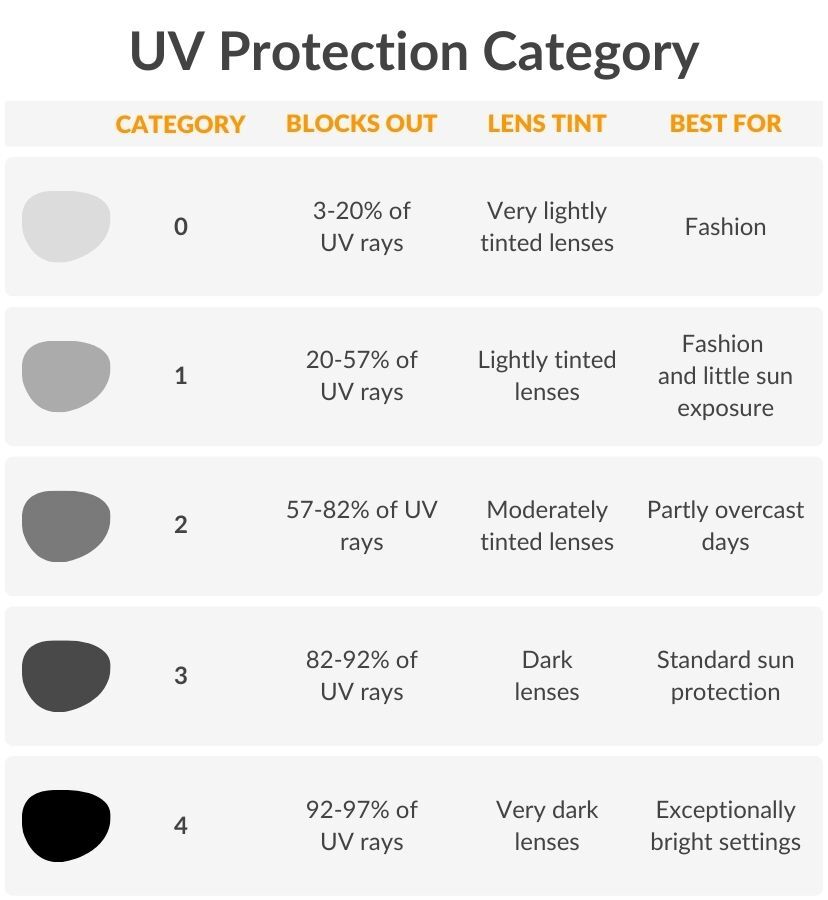UV Protection Sunglasses - How Different Protection Categories Work
UV protection categories | Category 3 vs 4 | 100% UV protection vs polarised

Reviewed by
Sharlene McKeeman FBDO
Many people use sunglasses as a fashion accessory to add a touch of sophistication to their style during the spring and summer months. However, not everyone is aware that UV sunglasses have a very practical purpose in addition to being fashionable.
The lenses protect your eyes from harmful UV rays, which are problematic on both clear and cloudy days. When exposed to the sun, our eye pupils constrict to filter the light before it hits our retina. When the UV rays are very strong, this natural filter isn’t enough and could lead to eye health issues. To help prevent various issues, you should wear sunglasses that provide UV protection.
People’s eyewear needs vary, so it’s only natural that sunglasses come with various lenses to accommodate various conditions and environments. The lenses usually fall into one of five levels that offer different UV filters in sunglasses.

What is category 0 UV protection?
Category 0 blocks out only 3-20% of UV rays, so not a viable option for eye protection. Category 0 sunglasses are indicated for fashion purposes only; an example is softly coloured tinted lenses.
What is category 1 UV protection?
Category 1 blocks 20-57% of UV. Category 1 sunglasses are best suited for fashion purposes or cloudy days with little sun exposure. These types of sunnies usually have light tints, like grey or purple.
What is category 2 UV protection?
Category 2 lenses block 57-82% of UV rays and are appropriate for partly overcast days. Category 2 sunglasses are typically lighter in colour than others. Perfect for spring!
What is category 3 UV protection?
Category 3 sunglasses block 82-92% of UV light, which makes these UV sunglasses an excellent choice for sun protection. These shades can be used in bright sunlight in the mountains or at the seaside.
What is category 4 UV protection?
Category 4 (UV400) lenses are the highest category available, blocking 92-97% of UV rays to provide maximum protection. Sunglasses with lens category 4 are ideal for exceptionally bright settings, such as at high elevations or sea.
However, it is important to note that they are unsuitable for driving due to the dark lens tint (even illegal in some countries like the UK).
DID YOU KNOW?
Should I get category 3 or 4 sunglasses?
To determine which UV protection category you should go for, you need to determine in which conditions you’ll use your sunglasses. Usually, most people buying sunglasses will get a standard category 3 pair.
Category 3 is the most common, ideal for bright sunny days in cities and holidays in the mountains or seaside. Category 4 sunglasses have extremely dark lenses and are recommended for extra bright conditions when the sun is very intense. For example, hiking at high altitudes, in the desert, or sailing in the open sea.
Is 100% UV protection better than polarised?
100% UV protection and polarisation are two different things. While UV protection sunglasses are designed to protect your eyes, polarised sunglasses are designed to reduce glare so you can see more clearly without squinting. People who play video games, water sports, or are bothered by glare daily choose these lenses.
Although polarisation has nothing to do with UV light absorption, many polarised lenses now have a UV-blocking material added to them. Older sunglasses with scratches on the coatings will not provide as much protection as newer UV protection sunglasses, so it is important to take care of them to ensure they protect your eyes.
Remember that UV protection is the most critical characteristic to look for and should be your top priority when buying sunglasses.
UV Protection Sunglasses - How Different Protection Categories Work
UV protection categories | Category 3 vs 4 | 100% UV protection vs polarised

Reviewed by
Sharlene McKeeman FBDO
Many people use sunglasses as a fashion accessory to add a touch of sophistication to their style during the spring and summer months.
However, not everyone is aware that UV sunglasses have a very practical purpose in addition to being fashionable.
The lenses protect your eyes from harmful UV rays, which are problematic on both clear and cloudy days. When exposed to the sun, our eye pupils constrict to filter the light before it hits our retina.
When the UV rays are very strong, this natural filter isn’t enough and could lead to eye health issues. To help prevent various issues, you should wear sunglasses that provide UV protection.
People’s eyewear needs vary, so it’s only natural that sunglasses come with various lenses to accommodate various conditions and environments. The lenses usually fall into one of five levels that offer different UV filters in sunglasses.

What is category 0 UV protection?
Category 0 blocks out only 3-20% of UV rays, so not a viable option for eye protection. Category 0 sunglasses are indicated for fashion purposes only; an example is softly coloured tinted lenses.
What is category 1 UV protection?
Category 1 blocks 20-57% of UV. Category 1 sunglasses are best suited for fashion purposes or cloudy days with little sun exposure. These types of sunnies usually have light tints, like grey or purple.
What is category 2 UV protection?
Category 2 lenses block 57-82% of UV rays and are appropriate for partly overcast days. Category 2 sunglasses are typically lighter in colour than others. Perfect for spring!
What is category 3 UV protection?
Category 3 sunglasses block 82-92% of UV light, which makes these UV sunglasses an excellent choice for sun protection. These shades can be used in bright sunlight in the mountains or at the seaside.
What is category 4 UV protection?
Category 4 (UV400) lenses are the highest category available, blocking 92-97% of UV rays to provide maximum protection. Sunglasses with lens category 4 are ideal for exceptionally bright settings, such as at high elevations or sea.
However, it is important to note that they are unsuitable for driving due to the dark lens tint (even illegal in some countries like the UK).
DID YOU KNOW?
Should I get category 3 or 4 sunglasses?
To determine which UV protection category you should go for, you need to determine in which conditions you’ll use your sunglasses. Usually, most people buying sunglasses will get a standard category 3 pair.
Category 3 is the most common, ideal for bright sunny days in cities and holidays in the mountains or seaside. Category 4 sunglasses have extremely dark lenses and are recommended for extra bright conditions when the sun is very intense. For example, hiking at high altitudes, in the desert, or sailing in the open sea.
Is 100% UV protection better than polarised?
100% UV protection and polarisation are two different things. While UV protection sunglasses are designed to protect your eyes, polarised sunglasses are designed to reduce glare so you can see more clearly without squinting. People who play video games, water sports, or are bothered by glare daily choose these lenses.
Although polarisation has nothing to do with UV light absorption, many polarised lenses now have a UV-blocking material added to them. Older sunglasses with scratches on the coatings will not provide as much protection as newer UV protection sunglasses, so it is important to take care of them to ensure they protect your eyes.
Remember that UV protection is the most critical characteristic to look for and should be your top priority when buying sunglasses.










































